Keeping a clean home is key to decreasing toxin exposure. Research indicates that a lot of toxins actually enter humans through breathing in household dust. So for example, toxic PFAS from the stain-resistant treatment on your couch slowly work their way off of the sofa and onto your floors and other surfaces, where they stick to the dust.
As that dust gets agitated and released into the air, you breathe it in—along with the PFAS. The same could be said for things like formaldehyde, phthalates, flame retardants, and other toxins that end up in our homes.
This is one of the reasons why regularly wet dusting your home and just generally keeping it clean is a relatively easy way to decrease your toxin exposure.
But… a lot of household cleaning products contain problematic ingredients, too! So in this article, I’m talking about some of the most common toxic ingredients to watch out for in all-purpose cleaners and then give you our favorite brands for non-toxic cleaning products that you can feel safe using.
My Picks At A Glance:
- Force of Nature (best disinfectant)
- Branch Basics (best concentrate)
- Healthybaby (best for babies & kids)
- Attitude (best scented)
- Meliora (best low-waste/plastic-free)
(some discount codes are below!)
Table of Contents: The Best Non-Toxic All-Purpose Cleaners
- Toxic Chemicals in Conventional Cleaning Products
- What About Sustainability?
- Are you Cleaning, Disinfecting, or Both?
- 7 Non-Toxic & Natural All-Purpose Cleaners (That Actually Work)
- Force of Nature (Best Disinfectant)
- Branch Basics (Best Concentrate)
- Healthybaby (Best For Little Ones)
- Attitude (Best Scented)
- Meliora (Best Plastic-Free)
- How Do You Make Non-Toxic All-Purpose Cleaner? (2 Easy DIY Recipes)
- A Closer Look At Other Popular “Non-Toxic” Cleaning Brands
This article contains affiliate links, which means we may earn a commission if you decide to make a purchase. As always, all recommendations are genuine and meet our standards.
Toxic Chemicals in Conventional Cleaning Products
Here are some of the ingredients that you may want to watch out for in conventional cleaning products:
1. “Mystery” Fragrances
I talk about fragrances all the time on The Filtery.
Almost all traditional cleaning products contain “Fragrance” as one of their ingredients. The fact is that this isn’t actually one ingredient; there are actually over 3,500 different chemicals that can legally be included in a product under that “fragrance” umbrella!
Some of those ingredients are completely safe, while others are classified as carcinogens, allergens, VOCs, and endocrine disruptors (including things like phthalates). The problem is that because of the lack of transparency that this loophole allows, it’s basically impossible for consumers to know the truth about what’s in their products.
With recent changes to California law, we’re starting to make progress towards more fragrance transparency. But we still have a long way to go!
So when you’re shopping for a non-toxic option for your all-purpose cleaner, look for a brand that is either fragrance-free or clearly lists its fragrance ingredients on the label. Of course, some conscious companies use essential oils as a way to provide a nice, clean scent in a safer and more natural way.
If you want to take a deeper dive into this issue, you can do that here.
2. SLS/SLES
Sodium lauryl sulfate (SLS) and sodium laureth sulfate (SLES) are commonly used in soaps and cleaning products. They are used as surfactants, which create lather and help to help pull oil away from the surface you’re trying to clean.
While SLS isn’t necessarily “toxic,” the primary concern is that it can cause skin irritation. Therefore, if you have eczema or another sort of skin sensitivity, you may want to steer clear of it.
SLES is a less harsh option that tends to be more gentle on the skin… However, it’s an ethoxylated ingredient, which can potentially be contaminated with a couple of carcinogenic ingredients due to the manufacturing process.
(Ethoxylated ingredients are practically impossible to completely avoid, but it’s something that may be worth trying to minimize when you can.)
3. Triclosan
Triclosan is actually a pesticide that used to be used in “anti-bacterial” products. It’s a very problematic ingredient, linked to all kinds of long-term health concerns like breast cancer and hormone disruption.
Although it’s still worth being aware of triclosan and keeping your eye out for it, the good news here is that it’s actually been pulled out of almost all cleaning products (even more ‘conventional’ ones) in recent years!
4. Quats
This is another pesticide commonly used in traditional cleaning products, especially those that are labeled as “anti-bacterial” or “anti-microbial.” This is another group of chemicals that is linked to skin and lung irritation as well as endocrine disruption (which can lead to infertility, birth defects, and more).
These ingredients often have “-onium chloride” somewhere in the name. For example, the active ingredient in Clorox’s Bleach-Free Disinfecting Crisp Lemon All Purpose Cleaner is Alkyl dimethyl benzyl ammonium chloride.
It’s also worth noting that the instructions for this product say that “All surfaces that come in contact with food must be rinsed with potable water,” indicating that it’s not really safe to use around your kitchen… (But also, who actually rinses surfaces after using an all-purpose cleaner on them in real life??)
4. Certain Preservatives
Ingredients like methylisothiazolinone and benziosothiazolinone are commonly found in cleaning products and soaps. These ingredients even sneak into some of the products that are marketed as “green.”
However, these ingredients are irritants and have been known to cause things like rashes and/or exacerbate conditions like eczema. So, if you have sensitive skin and using brands like Seventh Generation or Mrs. Meyer’s is not helping with your symptoms, this could be why.
What About Sustainability?
Of course, environmental safety and human health go hand-in-hand. In addition to non-toxic ingredients, you may also want to consider the environmental impact of your cleaning products. Some other things you may want to look for are:
- How low-waste is the cleaner (do they offer a plastic-free or refillable option)?
- Is the formulation biodegradable?
- Does the solution use plant-derived ingredients that are free from petroleum derivatives and sourced in a sustainable way?
- Is the cleaner vegan and/or cruelty-free?
Although there’s no perfect brand, the all-purpose cleaners listed below have many of these eco-friendly characteristics.
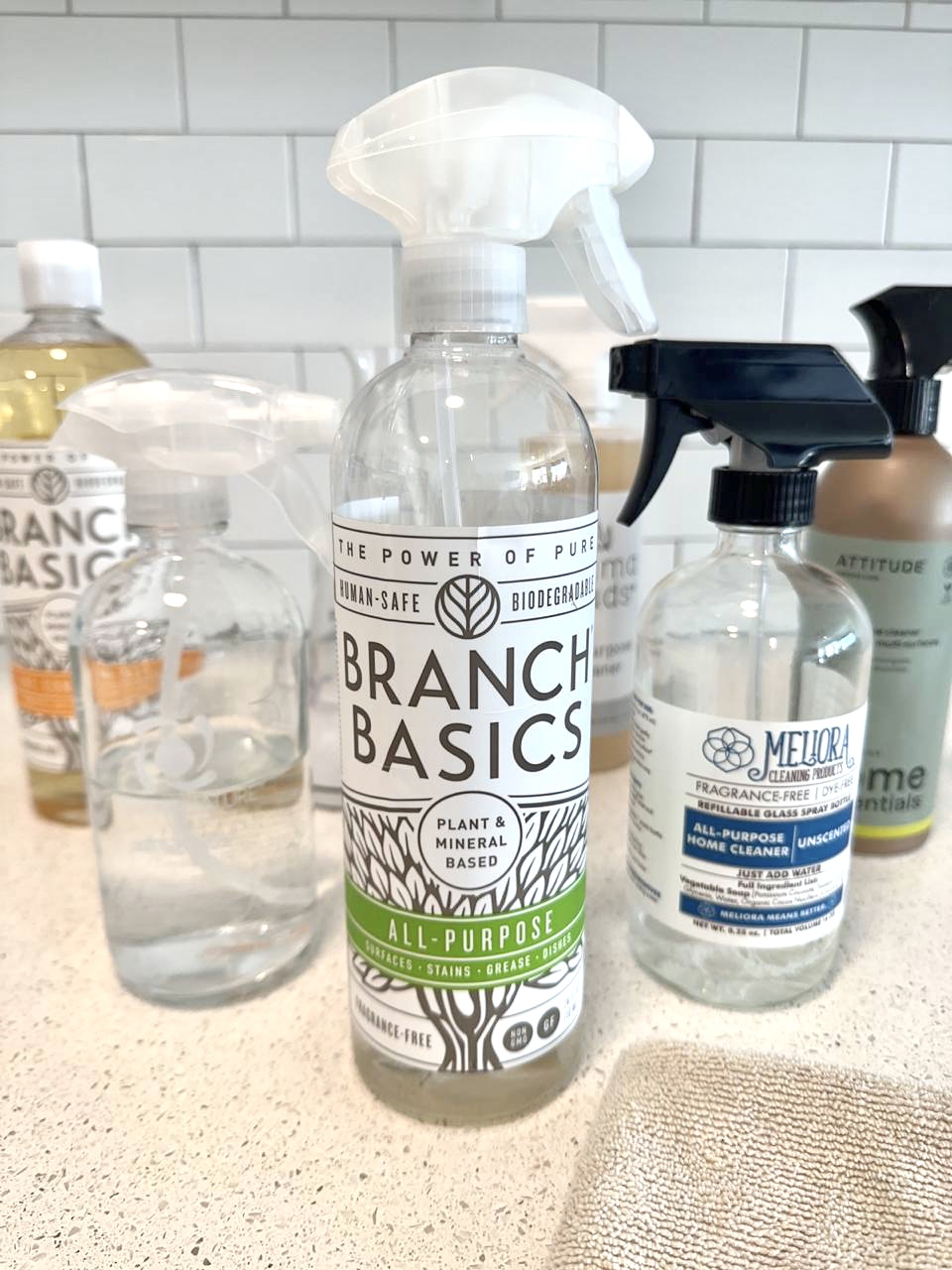
Are you Cleaning, Disinfecting, or Both?
It’s worth noting here that cleaning and disinfecting/sanitizing are not always the same thing. Here is the difference according to the CDC:
- Cleaning consists of the removal of germs, dirt, and impurities from surfaces. It does not kill germs, but by removing them, it lowers their numbers and the risk of spreading infection.
- Disinfecting consists of using chemicals to kill germs on surfaces. This process does not necessarily clean dirty surfaces or remove germs, but by killing germs on a surface after cleaning, it can further lower the risk of spreading infection.
In other words:
- You can clean a surface by wiping away all of the dirt and grease without actually killing the germs, bacteria, and viruses that exist on that surface.
- OR you can disinfect a surface simply by spraying it with a chemical (whether or not you actually wipe away the dirt and grime).
Of course, many cleaning products are meant to do both.
Obviously, there are going to be situations where disinfecting and sanitizing surfaces is the necessary or desired outcome. However, research indicates that over-using disinfectants may contribute to antibiotic resistance, superbugs, and an overall decrease in immune function over time. Some research also indicates that using anti-bacterial products isn’t actually more effective in preventing disease when compared to “normal” cleaning products.
If and when you do use disinfectants, I recommend skipping the triclosan, quats, and other harsh chemicals and instead choose safer alternatives like hypochlorous acid (which is what Force of Nature uses), alcohol, citric acid, or hydrogen peroxide.
RELATED: The Best Non-Toxic Hand Sanitizer Brands
7 Non-Toxic & Natural All-Purpose Cleaners (That Actually Work)
Okay, so now that you know what to look out for in your cleaning products, let’s get to our recommendations!
Force of Nature (Best Disinfectant)

Price: $70 for starter kit; 9 cents per ounce
Type: Multi-purpose disinfectant
Certifications: EPA registration; highest rating on the Mayo Clinic’s Skin Safety platform
Subscription? Yes, you can save 7% with a 2, 3, or 6-month subscription for more activator capsules
Force of Nature is a new kind of household cleaner that uses electricity to transform salt, vinegar, and water into a solution that is tested and confirmed by the EPA to kill 99.9% of germs and viruses without any harmful ingredients.
Actually, the technology itself isn’t new; it’s been used in medical and veterinary settings for a long time! But until Force of Nature figured out how to bring the tech into your home, it hasn’t been available for consumers.
There’s a slight learning curve to using Force of Nature, but after you do it once, you’ll see how easy it is! And one of the things I love about it is that it is truly a multi-purpose product—there are SO many different ways to use it! You don’t have to rinse it, so you can spray it on furniture, strollers, fruits & veggies, clothing, doorknobs, and basically any kind of surface to disinfect and just generally freshen things up.
Force of Nature contains only 3 ingredients, which means zero fragrances, preservatives, allergens, carcinogens, etc. You can read my full review of Force of Nature right here!
You can use the code THEFILTERY30 for 30% off Starter Kits & bundles.
Branch Basics (Best Concentrate)
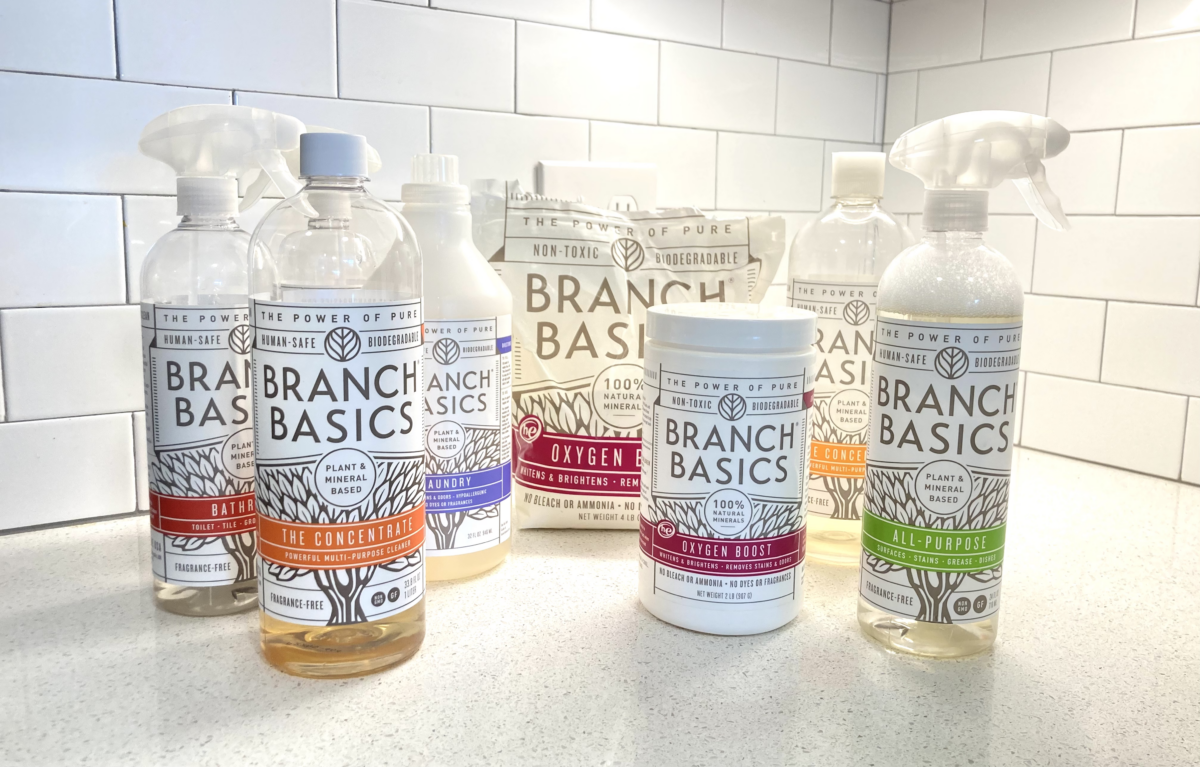
Price: $75 for Starter Kit; $55 for Concentrate Refill
Type: Liquid concentrate
Certifications: MADE SAFE; EWG Verified; Leaping Bunny
Subscription? Yes, you can save 10% with a subscription
Branch Basics is one of my favorite non-toxic cleaning products that you can use not only for everyday cleaning but also in the bathroom, the laundry, as hand soap, and more.
It’s gentle and safe for all of the family members, but it can also quickly cut through grease and get the job done. It’s also MADE SAFE certified to be free from any and all harsh chemicals and is fragrance-free, biodegradable, and cruelty-free.
Their spray bottles (which you can get in either glass or plastic) come with fill lines so you know what ratio of water to concentrate to use for each purpose (all-purpose, bathroom, streak-free, hand soap, or laundry).
Even though a bottle of concentrate is a bit pricey, it lasts a long time (even if you clean a lot!).
In addition to the all-purpose concentrate, Branch Basics also carries an oxygen boost for the laundry, dishwasher tablets, travel-sized bottles, and more.
You can find my full review of Branch Basics here.
You can use the code THEFILTERY for 15% off Starter Kits.
Healthybaby (Best For Little Ones)
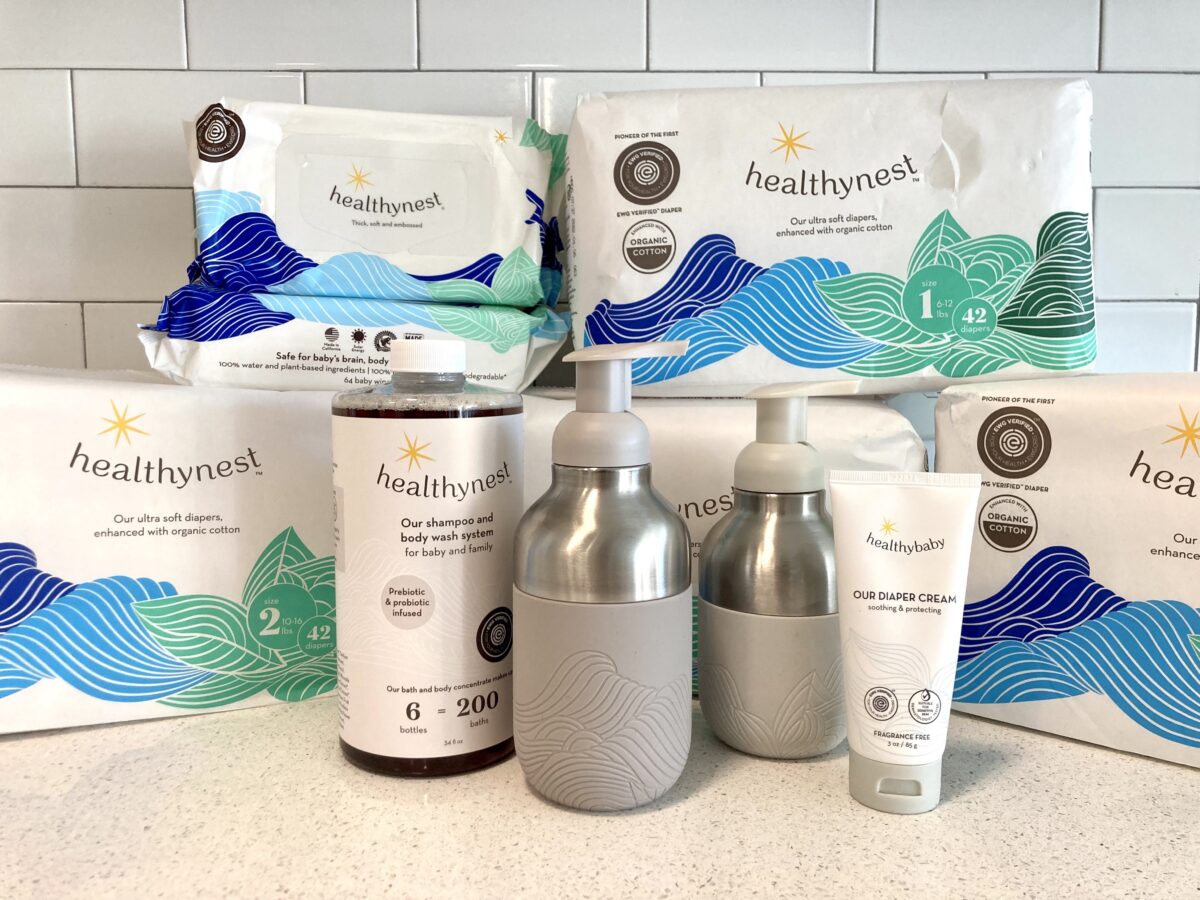
Price: $60 for the initial Cleaning System; $27 for concentrate refill
Type: Liquid concentrate
Certifications: MADE SAFE; EWG Verified; B Corp
Subscription? No subscription is available for the cleaning solution (they do have a diaper & wipe subscription option, though)
With their diapers, wipes, and baby skincare, Healthybaby’s products are targeted toward parents with little ones. Although technically, their all-purpose cleaning concentrate is great for any kind of household—kids or not!
You can start out with their Cleaning System, which includes a bottle of the concentrate; 3 reusable stainless steel bottles for hand soap, dish soap, and surface spray; and 3 reusable dishcloths. Then after that, you can just grab a bottle of the Cleaning Concentrate whenever you need a refill.
Healthybaby’s all-purpose cleaner comes with the MADE SAFE certification, which is one of our favorites for safety of ingredients. They use ingredients like coco-glucoside, which is a plant-based cleanser derived from sugar(!), along with several other natural and organic ingredients.
In addition to being used as a standard all-purpose spray, it can also be used used as a foaming hand soap, dish soap, laundry detergent, spot treatment, and more.
Attitude (Best Scented)

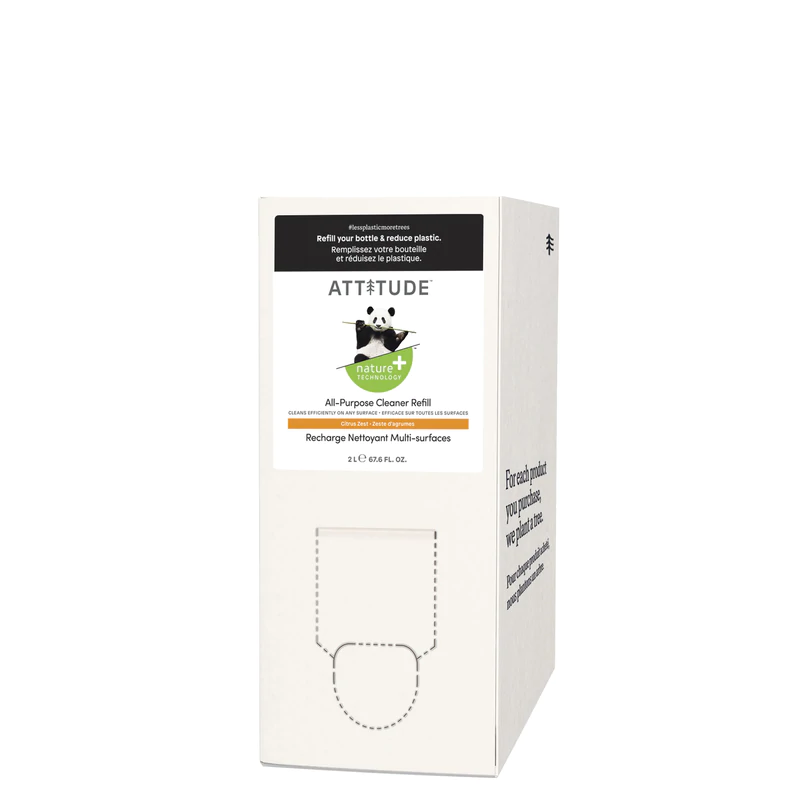
Price: $5.95+
Type: Regular cleaning spray with a refill in a box
Certifications: ECOLOGO, EWG Verified, PETA vegan & cruelty-free,
Subscription? Yes, you can save 10% with a subscription model
If you’re a fan of the scented cleaning sprays, you should check out ATTITUDE. Scents include Citrus Zest, Lavender, and Pink Grapefruit (in addition to Unscented).
For the active cleaning ingredients, ATTITUDE uses things like saponin, which is a natural, streak-free cleaning agent that truly works on everything from light dust to soap scum. After you buy your first spray bottle, you can get refill boxes with a spout to cut down on plastic.
In addition to their all-purpose cleaner, they also carry specific cleaning sprays for the bathroom, kitchen, floor, fruits & veggies, and more… And it all smells amazing! But not only that; ATTITUDE also has basically any and every other type of personal care and home cleaning product you need, from laundry detergent to haircare to lotion and more.
Meliora (Best Plastic-Free)

Price: $10+
Type: All-Purpose Home Cleaner Spray (with dissolvable refill tablets)
Certifications: MADE SAFE, B Corp, Leaping Bunny, 1% For the Planet
Subscription? Yes, you can subscribe and save 5%
Although all of the brands listed here are lower waste than your more conventional cleaning products in one way or another, Meliora actually provides a single-use plastic-free cleaning option.
Their unscented (fragrance-free) all-purpose cleaner comes in a glass bottle with a dissolvable tablet, which you can then buy more of when you’re ready for refills. All you have to do is add warm water, shake, wait a sec for it to dissolve, and get cleaning!
Meliora’s cleaning products are also MADE SAFE certified so you know they’re completely free from toxins. Their ingredient list is really short; it only includes a few plant-based ingredients. I’ve been using their all-purpose cleaner for years now and we use it all over the place: on counters, in the bathroom, and even on mirrors and glass for a streak-free clean.
In addition to their all-purpose cleaner, they also have other cleaning products like dish soap, cleaning scrub (for tougher jobs), laundry detergent, foaming hand wash, body wash, and more. Everything is made in the USA at their Chicago, IL factory.
Check out out full Meliora review right here.
Use code THEFILTERY10 for 10% off.
How Do You Make Non-Toxic All-Purpose Cleaner? (2 Easy DIY Recipes)
If you’re the type of person who’d rather make their own non-toxic cleaning products, here are a few super-easy recipes you can use to make your own natural cleaning products:
Using Soap:
- 2 cups of water (you can use tap, or distilled/filtered is even better)
- 4 teaspoons castile soap (such as Dr. Bronner’s)
- 30-35 drops of the essential oil of your choice (ones with citric acid, such as lemon or grapefruit, tend to be better at cutting through grease as well as sanitizing)
Using Vinegar:
- 3 cups water
- 1/2 cup white vinegar
- 10-20 drops of the essential oil of your choice
(It should be noted, however, that vinegar can damage certain surfaces, like natural stone, tile, and wood—so be careful!)
Tips for Using:
- Use a glass bottle if you can
- Store in a cool, dark place (some essential oils can oxidize if left in the sunlight)
- Shake before each use
Here are some more easy DIY recipes if you’re interested!
Related:
Home
9 Organic Kitchen Towels for Sparkling Dishes
Not only are organic kitchen towels more eco-friendly and healthier for your home, but they also tend to be of a higher quality. Here are our favorite brands!
A Closer Look At Other Popular “Non-Toxic” Cleaning Brands
You may notice that there are a few other “natural” and “non-toxic” cleaners that aren’t on this list… Brands like Method, Mrs. Meyers, and Seventh Generation have become almost as mainstream as the more ‘conventional’ brands like Windex and Clorox in recent years.
The main problem with these brands is that some of their products are in fact non-toxic or even “pretty good,” while other products are just as bad as their conventional counterparts! This is problematic because it requires consumers to know a lot about hard-to-pronounce ingredients and do a bunch of research on each individual product before buying it… Most of us don’t have time for that!
In general, I’d say that these brands are better than most of the conventional brands… But they’re definitely not the best.
Let’s take a look at some of the specific brands…
Method
Almost all of Method’s products (the worst ones as well as the “less bad” ones) contain questionable things like several different ethoxylated ingredients, mystery fragrances, methylisothiazolinone (a known skin irritant), and other random things like methylbenxyl acetate, which is a suspected hormone disruptor.
Also, Method makes it relatively difficult to find their ingredients at all, which I don’t like because I believe in full ingredient transparency. Consumers shouldn’t have to dig and dig to find out what’s in the products they’re buying!
Mrs. Meyer’s
Mrs. Meyer’s products have a lot of the same problems that Method’s do (although, they’re generally a little bit better and they do prioritize transparency more than Method does).
The main problems with Mrs. Meyer’s ingredients are mystery fragrances, methylisothiazolinone and benzisothiazolinone (known irritants), and a lot of ethoxylated ingredients.
However, Mrs. Meyer’s does at least indicate that their fragrances are made without phthalates or parabens.
Seventh Generation
Seventh Generation is very similar to Method and Mrs. Meyer’s. Some of their products are better than others, but a lot of them contain toxic methylisothiazolinone and benzisothiazolinone. Their Free & Clear cleaners are free from mystery fragrances, so that’s something. But again, I still don’t really recommend this brand on the whole…
Here are some related cleaning guides you may be interested in checking out:
Here are some related cleaning guides you may be interested in checking out:
- The best non-toxic laundry detergent brands
- Our favorite dish soap & dishwasher detergent brands
- Safest alternatives to dryer sheets
- Where to find eco-friendly and non-toxic paper towels
There’s really no reason to have to make sacrifices when it comes to all-purpose cleaning spray. There are plenty of natural and non-toxic cleaning products on the market that you can feel safe using around your whole family (including kids and pets!).
To stay updated on news and get more tips, tricks, and other exclusive content delivered to your inbox, sign up for Filtered Fridays!





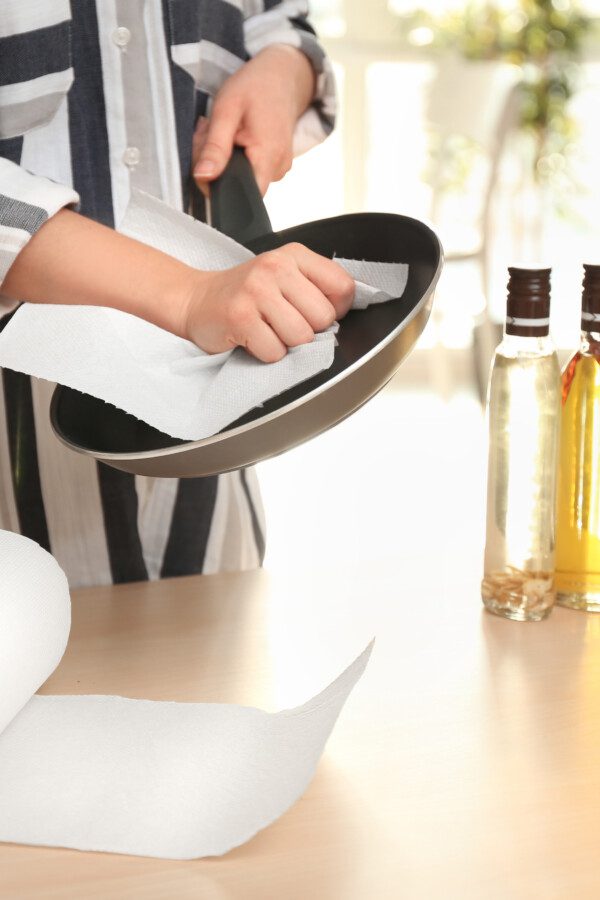
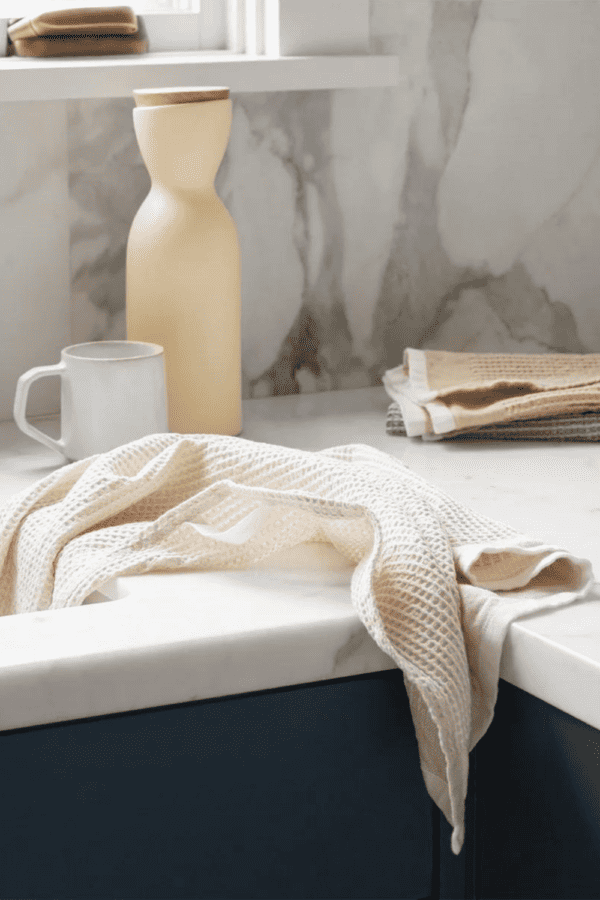
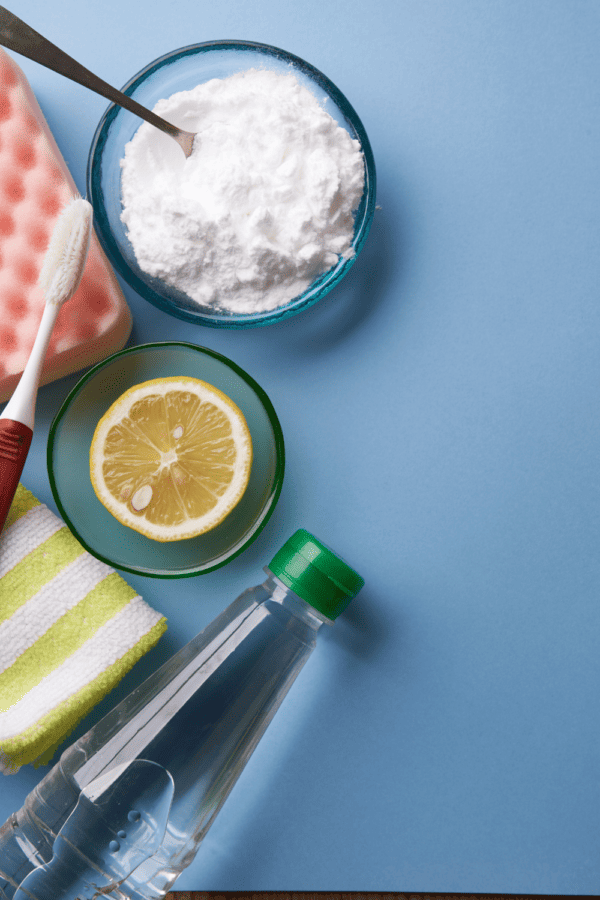




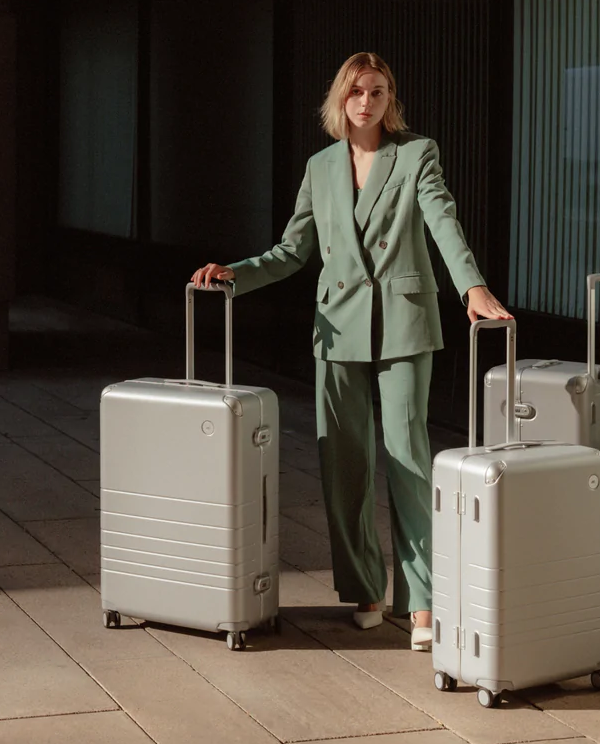
Hi, I recently learned about The Filtery and am really impressed by your thorough and science-based reviews. Thank you for all your work!
One question I had was about Dr. Bronners. I see that in various articles you mention them in passing, but I can’t find an in-depth review on their products or any specific products of theirs (except, I think, their lip balm?). Is there a reason they haven’t been reviewed closely?
Thank you!
Jay
Hi Jay, thanks for reading! We have not done a full review on Dr. Bronner’s yet, but I’ve added it to my list! In terms of the safety of ingredients though, it’s a great brand. 🙂